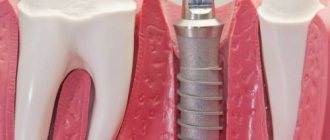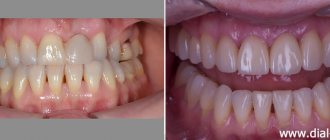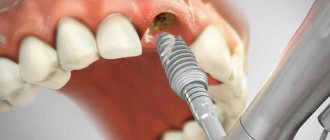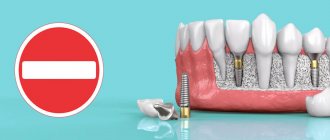What does basal dental implantation mean?
This term refers to the technique of implanting special implants not just into the jawbone, as with classical implantation, but into its deep parts. The term basal in the name of the technique indicates that the implant penetrates the basal layer of the bone. The peculiarity of the technique is that it allows prosthetics to be performed in a fairly short period of time - within one week, or even less.
Patients in dental clinics should also know the alternative names for basal implantation: transgingival, single-stage, minimally invasive, single-phase or implantation with immediate loading.
The main point of the basal method of dental implantation is the very rapid restoration of chewing load - the installed dentures can be loaded within 3-5 days after completion of all procedures. As part of the technology, the dental surgeon also uses the zygomatic bone to securely fix the implants in the jaw (when replacing the upper jaw). When placing implants, the force lines of the skull are taken into account, which allows for optimal distribution of the load on the prostheses.
Basal dental implantation allows the patient to save time compared to conventional implantation. With the classical scheme of prosthetics on implants, from the moment of installation of the implant to prosthetics takes from 3 to 6 months, and with basal implantation - from 3 to 5 days. But fast does not always mean high quality, and any patient may face the problem of basal implant rejection within a couple of months.
We note the rapid growth of patient interest in basal implantation and would like to meet their expectations. But! Having carefully studied the issue of basal implantation, we came to the conclusion that the technique is too ambiguous. In addition, in most European countries, where this method is supposedly actively used, it has almost been abandoned due to the high risk of complications. This is why basal implantation is not encouraged or used at Dent Academy - we try to follow European recommendations.
Differences from other treatment options
In classical implantation, the implant is implanted into the spongy layer of bone tissue. With basal implantation, no reconstructive operations are performed and the implant is not installed in the main bone adapted to the load. The implant is installed into another structure - into the “basal bone”. This is synonymous with the cortical plate of the jaw bone, the outer layer of bone tissue that surrounds the cancellous bone in the form of an external frame and disappears later than others when the bone atrophies.
There is documented data confirming the presence of areas of this kind even with complete atrophy of the jaw bones. However, there is currently no data proving the long-term service of basal implants. Yes, the basal bone is much less susceptible to atrophic processes, but it is not suitable for reliable and durable installation of implants.
When selling such compromise solutions to the patient, the doctor emphasizes that before undergoing classical implantation, the patient must go through a complex and expensive process of increasing lost bone mass - bone grafting, which requires a long recovery period. And that basal implantation is the only optimal option for restoring the dentition for patients who have significant bone atrophy and contraindications to bone grafting, as well as fear of bone grafting.
None of this is entirely true. If you have a little free time, basic English and Internet access, you can easily find that all over the world this implantation technology is called Temporary Implantation and is never used anywhere to simulate permanent dental implantation. Yes, the basal (cortical) bone never atrophies, but what good is this if non-root-shaped implants with the thickness of a matchstick are installed? The biomechanics of chewing cannot be deceived and the masticatory muscles, trying to distribute chewing overloads to elements unsuitable for chewing, overload them. Overload leads to resorption of the last boundaries of the bone and rejection of the implants. It is very interesting to observe how orthopedists, knowing about this feature of basal implants, connect these structures with proprietary bridge-like structures, trying to strengthen it and prevent food from entering.
Basal implantation is called immediate loading implantation. This is true. Temporary implants are designed for this purpose. You can immediately install plastic temporary crowns on them, but this does not mean that already 2-3 days after implantation, it will be possible to install a ceramic denture and thereby permanently restore chewing function and get rid of the aesthetic defect.
Types of Basal Implants
There are two types of basal implants: disc and compression. Disc ones are not currently used, having given way to more modern compression ones.
Disc implants
During the era of basal dental implantation, disc implants, also called lateral basal implants, were developed and actively used. To install them, a rather traumatic operation was required, during which the gums were cut and the bone was sawed out. For this reason, disc basal implants were gradually replaced from clinical practice by more convenient compression ones.
Compression implants
The development of dental surgery has led to the emergence of a new generation of basal implants - compression or root-shaped. These implants are similar to conventional ones, but are larger in size, allowing them to “reach” the basal layer of bone.
Basal implants are produced in different countries and are represented on the market by a large number of manufacturers. Dental clinics usually use implants from 2-3 manufacturers - this is enough to cover the entire price range.
Dental implants: types and prices with photos
The quality of basal implants from all well-known manufacturers is approximately comparable - it is very difficult to identify the leader among them, since it is impossible to objectively compare the number of complications, service life and the presence of defects. In addition, to a certain extent, these indicators depend on the “straightforwardness” of the doctor installing the implant. Therefore, briefly about implants from well-known manufacturers:
- Nobel Biocare (Switzerland). The implants of this company are made of titanium, which has a high degree of biocompatibility. The external coating of Nobel implants is represented by TiUnit material, which is titanium oxide enriched with phosphorus and has a high degree of crystallization. This coating provides moderate surface roughness of the implant, which increases their survival rate and reduces adaptation time. Nobel Biocare is one of the leaders in the production of implants and equipment for implantology; the company provides a lifetime guarantee on its products. The quality of the product also corresponds to the price - the cost of an implant for basal dental implantation starts from 60,000 rubles.
- Straumann Roxolid (Switzerland). This company uses a special alloy in the production of its implants, which in some respects is not inferior to titanium. Dental implants from Straumann Roxolid are thin, short implants with a special coating that facilitates installation in patients with several concomitant diseases. The price of these implants is slightly lower than the prices of flagships from Nobel - the average cost of one Straumann Roxolid implant is 50,000 rubles.
- Oneway Biomed (Switzerland). Biomed implants are recognized leaders around the world among all immediate loading implants. The Immediate Load implantation protocol developed by the company in addition to implants made the prosthetic procedure so convenient that many implantologists with conservative views began to introduce it into their practice. Biomed implants are distinguished by a super-smooth surface that prevents the absorption of microorganisms. These implants are suitable for prosthetics in the most advanced cases - in patients with severe atrophy of the jaw bone tissue and severe periodontitis. With the cost of one Biomed implant being 25-35 thousand rubles, basal dental implantation of one jaw will cost about 200,000 (all-in-6 or all-in-4 protocol).
- Noris Medical (Israel). The implants from this manufacturer are focused on zygomatic (zygomatic) implantation, so their length exceeds the length of all other implants. In more than half of cases, zygomatic implantation is associated with the need to compensate for bone tissue deficiency. In this regard, Noris Medical offers doctors complete systems that include all the necessary components. The price of basal dental implantation with upper jaw prosthetics using all-in-6 or all-in-4 protocols using implantation systems from Noris Medical can reach several hundred rubles (this is the cost of zygomatic implantation of the upper jaw).
- Ankylos (Germany). The popularity of this company's products is due to their lower price category. The design features of implants from this manufacturer reduce the likelihood of their loosening. In the manufacture of implants, the patented FIRADENT Plus technology is used, thanks to which, after installation, more active formation of bone tissue is observed in the peri-implant space.
- BioHorizons (USA). The fame of this American brand is due to some extent to the fact that the company has developed a special coating for its implants - Laser-Lok. Thanks to it, the fusion of the implant with the bone tissue is accelerated. The company also patented the TeethXpress technique, which is a modification of All-on-6 and is intended for complete jaw replacement. This technique has only one drawback - for high-quality prosthetics it requires absolute parallelism between the implants, which cannot always be ensured in case of severe atrophy of bone tissue.
- Osstem Implant (South Korea). The South Korean company is one of the top 5 manufacturers of dental implants and implantation systems, accounting for 80% of the South Korean market. The company's products are quite affordable - the cost of one implant is 20,000 rubles. Since 2006, Osstem has been producing implants at its plant in the USA and selling them under the HIOSSEN brand.
Dental implantation - procedure and types of implants
Dental implantation today is one of the most modern ways to regain a dazzling smile. However, the selection of implants itself is a rather difficult procedure, which cannot be dealt with without the help of a specialist. In addition, most dental clinics specialize only in certain types of implants, so finding the one that is right for you usually takes a lot of time. What should you pay attention to when deciding to get dental implants? Let's look at this issue in more detail.
Implantology exists relatively recently. It appeared in the 60s of the last century, thanks to research carried out in the field of osseointegration - the implantation of titanium into human bone. For the first time, the installation of an artificial titanium root in a human jaw was carried out in Sweden, but only 20 years after its discovery, this technique began to gradually gain popularity among organizations providing dental services. Today, the installation of dental implants is one of the most popular areas of dentistry.
Chain of dental clinics "Pearl Elephant"
An implant is a dental root made of titanium, installed in place of an extracted tooth. Titanium has a unique ability - it can implant itself into human bone tissue, which has made it possible to widely use it to create dentures.
A dental implant consists of 3 main elements, which include:
- An implant is the main part of an artificial tooth;
- A crown placed on the implant;
- Abutment is the connecting part of the implant and the crown.
The use of this design is very convenient, since it allows the replacement of an abutment or crown without the need to touch the implant.
Today, approximately 2,000 systems have been created that allow dental implantation. Moreover, the cost of installing an implant and its abutment directly depends on their manufacturer, cross-sectional shape, thread and other characteristics of the prosthesis being manufactured.
Technology for installing dental implants
The implant installation itself is not a very painful procedure. There are no nerve endings in human bone tissue, which means that all unpleasant sensations can only come from the gums, which have to be cut to provide free access to the bone. To relieve discomfort, dentists can use both local anesthetics and general anesthesia. The time spent on the procedure is usually no more than an hour.
Installation of implants - its main stages
After an incision has been made in the gum, a hole is made in the bone using a special drill, which must coincide with the shape of the implant being installed. After this, a special plug is installed into the implant, temporarily replacing the abutment, and a suture is placed on the gum. The gums heal from 7 days to 3 weeks. After this, the suture is removed and within several months the implant becomes accustomed to the bone tissue. After completing this stage, a small incision must again be made on the gum to remove the plug and place a special gum former, protruding slightly above it and shaped like the tooth being installed. As a rule, gum formation takes no more than 2 weeks. After this, the doctor makes an impression. Based on this impression, a crown is made, which, together with the abutment, is installed on the implant.
Which implants should be preferred? Their main varieties
Dental implants are divided into 3 groups:
- Intraosseous - they are divided into:
- Subperiosteal;
- Transosseous.
Plate – used extremely rarely, only if the bone in which the implant is placed does not allow the installation of its screw version; Root-shaped; Combined - the most popular is its screw modification, which can be made with different thread shapes, types of coating, be dismountable or not disassembled, and also differ in the steps required for its installation.
In order to correctly select an implant, you should pay attention to its main characteristics, which include:
- Manufacturer - domestically produced implants, as a rule, have a more affordable price, but their quality leaves much to be desired.
- Technical characteristics - structure and how exactly it is connected to the abutment.
In general, in order not to make a mistake with your choice, it is enough to adhere to several rules:
- Give preference to implants that have a porous surface - they take root much better than smooth ones.
- If possible, opt for an option that is not polished and has micro-threads.
- Give preference to the conical connection, since it is the most airtight.
Pros and cons of basal implantation
Dental prosthetics based on the basal implantation technique is a very controversial technique, which has more significant disadvantages than advantages. It is most often offered in cases of complete edentia, when absolutely all teeth are missing on one jaw. Basal dental implantation is used in cases of severe atrophy of bone tissue without prior augmentation.
Basal implants are installed faster than usual, and the patient receives the desired effect in the form of restored dental integrity in the shortest possible time. However, this is accompanied by a fairly high risk of implant failure in the early stages.
Dentures on basal implants, however, as well as on conventional ones, do not require special care - it is enough to brush your teeth as usual or use an irrigator. When using all-in-4 and all-in-6 dentures, a small gap is usually left between the denture and the gum to facilitate oral care, which can be easily cleaned with a simple rinse.
Basal implantation is impossible without the use of computer technology - before the procedure, the implantologist must create a 3D model based on a CT scan of the jaw, which will help calculate the installation of implants. Unfortunately, many doctors neglect this need, saving on software, which leads to very sad results.
So, let’s briefly note the advantages of basal dental implantation:
- quick installation;
- the patient gets the opportunity to return to a normal lifestyle - chewing function is quickly restored, the cosmetic defect (lack of teeth) and the resulting psychological discomfort disappear;
- there is no need to build up bone tissue in case of severe atrophy;
- bone tissue regenerates faster due to immediate load on it;
- lower cost compared to alternative prosthetic methods.
Disadvantages of basal implantation
Doctors at Dent Academy are proficient in all methods of prosthetics, and we do not need to praise one method at the expense of another. Therefore, we will also talk about the disadvantages of basal prosthetics. And you will understand why this technique is not used in our clinic.
One of the serious disadvantages that should be immediately noted is the rather high complexity of the procedure itself - not every doctor is able to perform basal implantation. Specialists proficient in this technique must first undergo training at the International Implant foundation, ultimately receiving a certificate. A doctor who knows this technique is both an orthopedist and a maxillofacial surgeon rolled into one. Our clinic has specialists who have completed all the necessary training, but this does not allow them to abuse the trust of patients and offer them a rather dangerous technique.
Important! In case of rejection of the basal implant, the patient will still have to resort to classical implantation with sinus lift. And this happens quite often, which is why we do not use this method of prosthetics.
Dental implantation in Omsk
What are implants made of?
Sometimes an implant is often understood as the entire structure that will be installed in the mouth. In fact it includes:
- implant - the “root” of the future tooth,
- abutment – connecting element,
- crown (or other type of denture).
Implant models differ in size in the range of 6–16 mm, the nature of the surface, the density of the thread, and the shape of the apex. All of them are made of titanium - it can fuse with bone. Titanium is so reliable that many manufacturers provide it with a lifetime free replacement guarantee: in case of failure, the manufacturer will provide a new implant.
After implant installation
Recommendations after implant installation are in many ways similar to those the doctor gives after tooth extraction. Depending on the patient’s health status and existing diseases, individual recommendations may be added.
Dental surgeon-implantologist Guseinov Arif Eskendarovich listed the actions and restrictions that must be observed by all patients after implant installation:
Avoid eating for 2 hours.
For 7-14 days, exclude physical and temperature stress: bathhouse, sauna, gym, etc.
For 7-14 days, follow a gentle diet: food should be soft, not very hot and not very spicy. You cannot chew on an installed implant until the engraftment stage has passed.
Maintain oral hygiene: carefully, but completely.
Use an antiseptic chlorhexidine solution in your mouth 5 times a day for 7 days. You only need to keep the solution in your mouth and not rinse your teeth with it.
Strict intake of medications prescribed by your implantologist: antibiotics, anti-inflammatory or others.
Further, caring for a tooth on an implant is the same as caring for your own teeth. Regular brushing with a toothbrush and toothpaste, use of rinses and dental floss. An irrigator is excellent for caring for gums around an implant and dentures.
The implantologist will invite you for an examination after 7 days and after a month to make sure that healing is proceeding normally.
The doctor will also help the gum take on a shape in which the soft tissue will tightly grip the future crown. This is an important stage that will ensure aesthetics and high-quality hygiene in the gum area.
On average, 4 months after installation, the implantologist will refer the patient for diagnostics and assess the condition of the bone tissue around the implant. A stable implant is ready for prosthetics!
Indications and contraindications for basal prosthetics
Supporters of basal implantation are trying to present this technique as almost a panacea and the list of indications for it is very large. We are not supporters of this method, so we cannot recommend it in any situation.
“The practice of using basal implantation in European countries has shown that it can cause too much damage to the patient’s health. Therefore, in some countries this method was banned at the state level.”
Chief physician of the Academy of Dent Sadov Igor Yuryevich, a specialist with more than 20 years of experience, member of the European Association of Implantologists, member of the International Congress of Dental Implantologists.
The list of contraindications to this method is quite extensive:
- oncopathology;
- decompensated diabetes mellitus;
- tuberculosis;
- untreated arterial hypertension;
- severe disorders of the coagulation system (hypocoagulation);
- pronounced hypertonicity of the masticatory muscles.
Ages under 22 years are a contraindication for this implantation method, since until this age the growth and formation of bones, including jaws, continues
This is interesting! Smoking is a relative contraindication to any type of implantation, due to the fact that smokers have almost 5 times lower chances of successful implantation. This is due to the fact that long-term smoking leads to a decrease in bone density, deterioration of microcirculation in tissues, and slower regeneration. Unscrupulous marketers claim that basal implantation is more effective in smokers, but there is no confirmation of this fact - the percentage of rejection of basal implants in this category of patients is no higher than the percentage of rejection of conventional ones.
Basal prosthetics for complete absence of teeth - price
Many clinics promote basal implantation as a cheaper method of dental prosthetics for completely edentulous patients. Indeed, even a superficial analysis of the prices for these two methods shows: the average price of one tooth restored using classical implantation in Moscow is about 40-45 thousand rubles, and when restoring the entire jaw using basal implantation, the price of one tooth is about 20 thousand.
The cost of prosthetics for the entire jaw will largely be determined by the implants chosen by the patient: if you choose budget models, it will be possible to keep within 200,000, and if you choose premium implants, the price for basal implantation in Moscow can be 500,000 rubles.
We urge our patients not to chase cheapness and approach the choice of prosthetics method with all seriousness. Despite the fact that we do not use basal implantation, we will select a method of prosthetics for any patient, taking into account his financial capabilities. In this case, the main selection criterion will be health safety!









